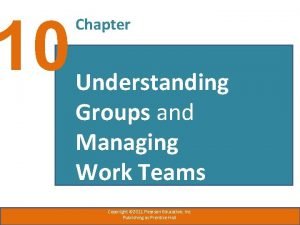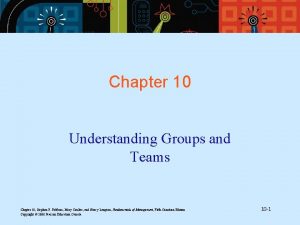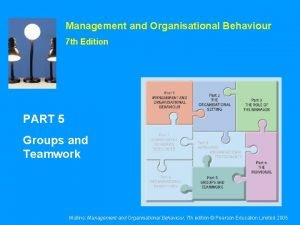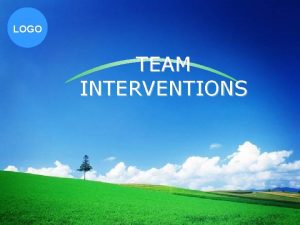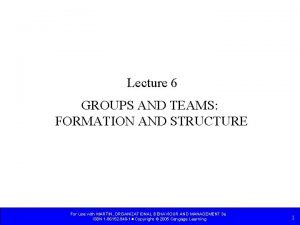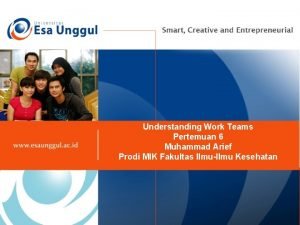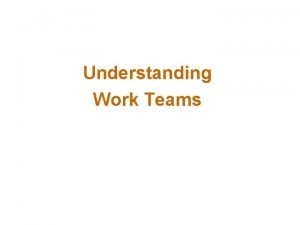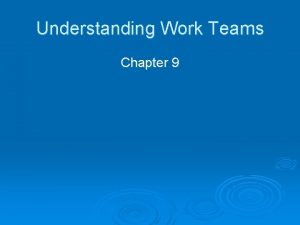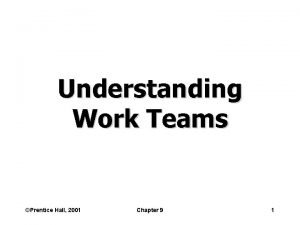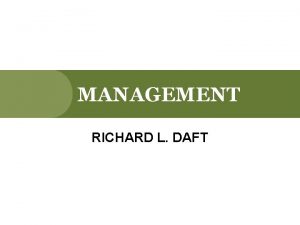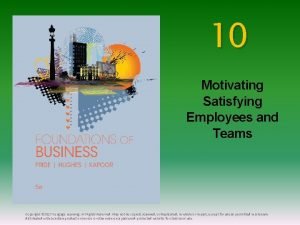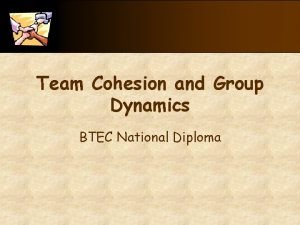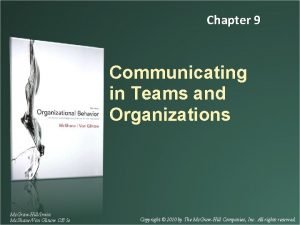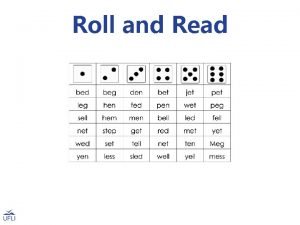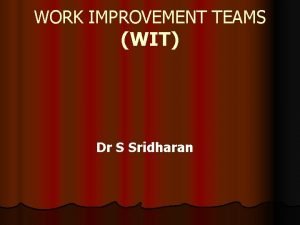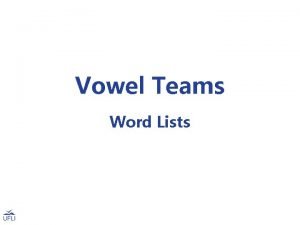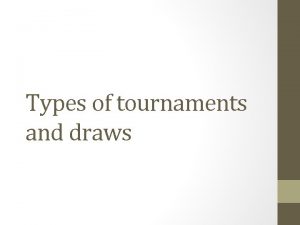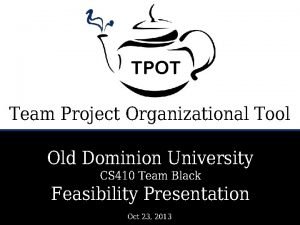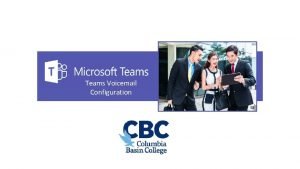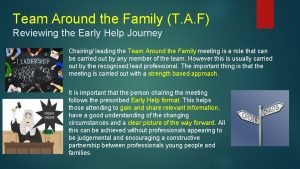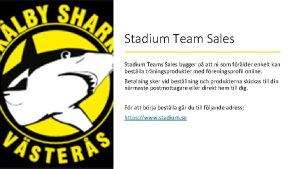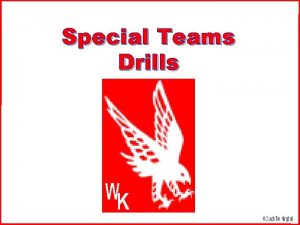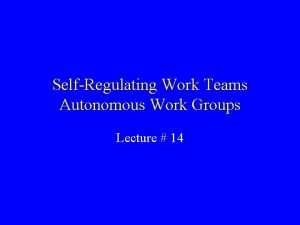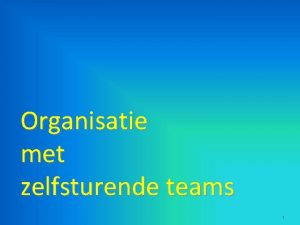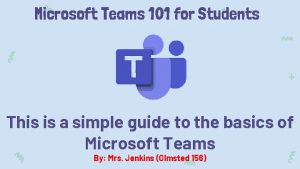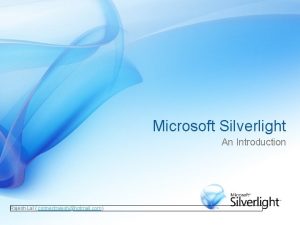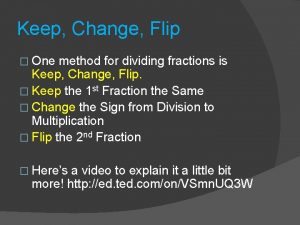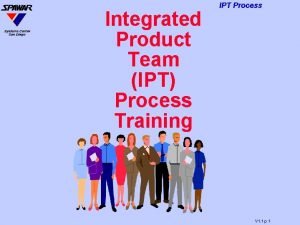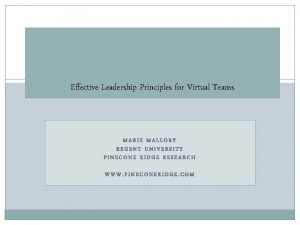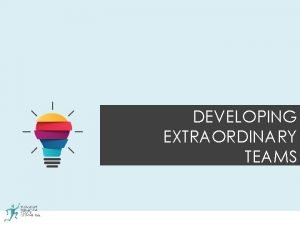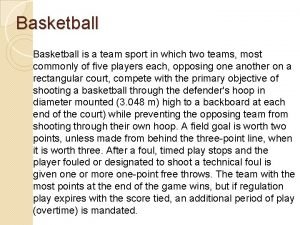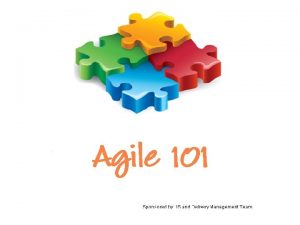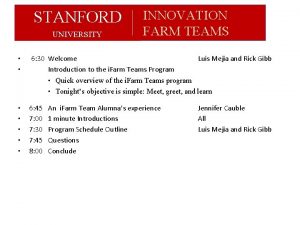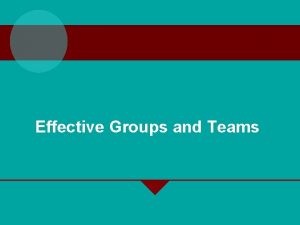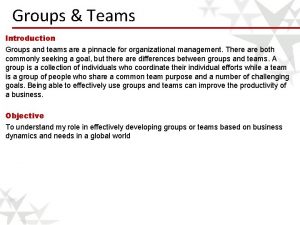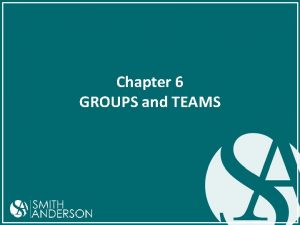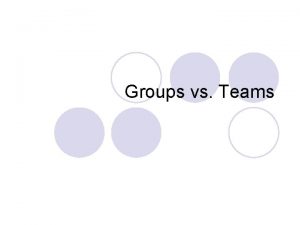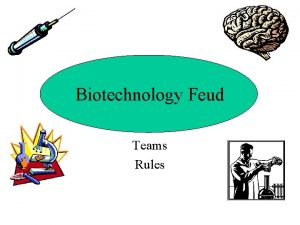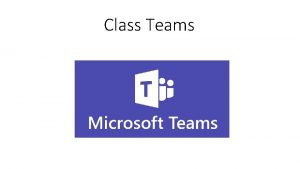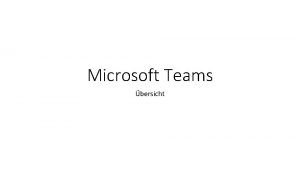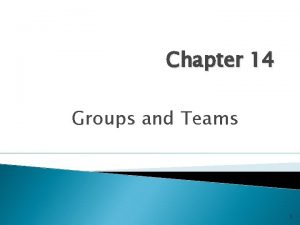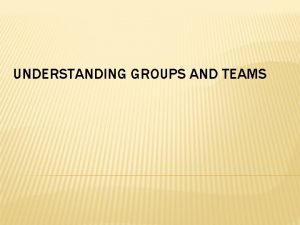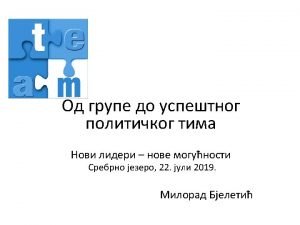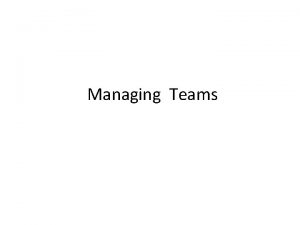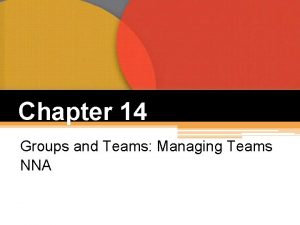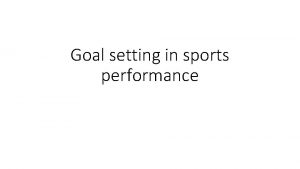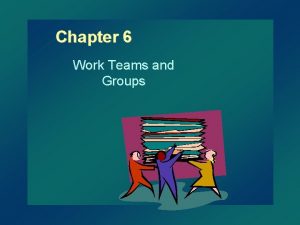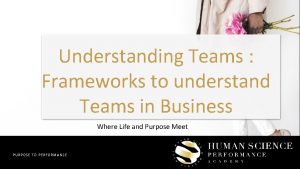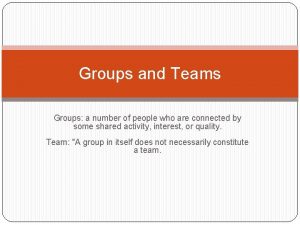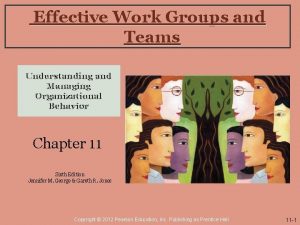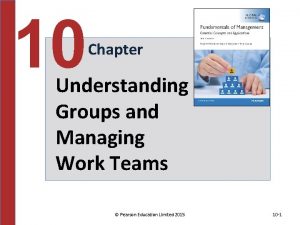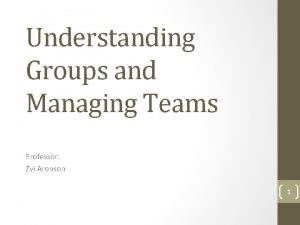Understanding Groups and Teams 2 3 Understanding Groups














































- Slides: 46

Understanding Groups and Teams

2

3














Understanding Groups • Group Ø Two or more interacting and interdependent individuals who come together to achieve particular goals. Ø Formal groups v Work groups defined by the organization’s structure that have designated work assignments and tasks. – Appropriate behaviors are defined by and directed toward organizational goals. Ø Informal groups v Groups that are independently formed to meet the social needs of their members. 15– 17

Stages in Group Development • Forming Ø Members join and begin the process of defining the group’s purpose, structure, and leadership. • Storming Ø Intragroup conflict occurs as individuals resist control by the group and disagree over leadership. • Performing Ø A fully functional group structure allows the group to focus on performing the task at hand. • Adjourning Ø The group prepares to disband is no longer concerned with high levels of performance. • Norming Ø Close relationships develop as the group becomes cohesive and establishes its norms for acceptable behavior. 15– 18

Stages of Group Development Exhibit 15. 2 15– 19

Group Behavior Model

Work Group Behavior • Internal Variables Affecting Group Behavior Ø The individual abilities of the group’s members Ø The size of the group Ø The level of conflict Ø The internal pressures on members to conform o the group’s norms

Conditions Affecting Group Behavior • External (Organizational) Conditions Ø Overall strategy Ø Authority structures Ø Formal regulations Ø Available organizational resources Ø Employee selection criteria Ø Performance management (appraisal) system Ø Organizational culture Ø General physical layout • Internal Group Variables Ø Individual competencies and traits of members Ø Group structure Ø Size of the group Ø Cohesiveness and the level of intragroup conflict Ø Internal pressures on members to conform o the group’s norms

Group Structure • Role Ø The set of expected behavior patterns attributed to someone who occupies a given position in a social unit that assist the group in task accomplishment or maintaining group member satisfaction. Ø Role conflict: experiencing differing role expectations Ø Role ambiguity: uncertainty about role expectations

Group Structure (cont’d) • Norms Ø Acceptable standards or expectations that are shared by the group’s members. Ø Common types of norms v Effort and performance – Output levels, absenteeism, promptness, socializing v Dress v Loyalty

Group Structure (cont’d) • Conformity Ø Individuals conform in order to be accepted by groups. Ø Group pressures can have an effect on an individual member’s judgment and attitudes. Ø The effect of conformity is not as strong as it once was, although still a powerful force. Ø Groupthink v The extensive pressure of others in a strongly cohesive or threatened group that causes individual members to change their opinions to conform to that of the group.

Group Structure (cont’d) • Status System Ø The formal or informal prestige grading, position, or ranking system for members of a group that serves as recognition for individual contributions to the group and as a behavioral motivator. v Formal status systems are effective when the perceived ranking of an individual and the status symbols accorded that individual are congruent.

Group Structure: Group Size • Small groups Ø Complete tasks faster than larger groups. Ø Make more effective use of facts. • Large groups Ø Solve problems better than small groups. Ø Are good for getting diverse input. Ø Are more effective in factfinding. • Social Loafing Ø The tendency for individuals to expend less effort when working collectively than when work individually.

Group Structure (cont’d) • Group Cohesiveness Ø The degree to which members are attracted to a group and share the group’s goals. v Highly cohesive groups are more effective and productive than less cohesive groups when their goals aligned with organizational goals.

The Relationship Between Cohesiveness and Productivity

Group Processes: Group Decision Making • Advantages Ø Generates more complete information and knowledge. Ø Generates more diverse alternatives. Ø Increases acceptance of a solution. Ø Increases legitimacy of decision. • Disadvantages Ø Time consuming Ø Minority domination Ø Pressures to conform Ø Ambiguous responsibility

Group versus Individual Decision Making Criteria of Effectiveness Accuracy Groups Speed Creativity Degree of acceptance Efficiency Individuals

Techniques for Making More Creative Group Decisions

Group Processes: Conflict Management • Conflict Ø The perceived incompatible differences in a group resulting in some form of interference with or opposition to its assigned tasks. v Traditional view: conflict must it avoided. v Human relations view: conflict is a natural and inevitable outcome in any group. v Interactionist view: conflict can be a positive force and is absolutely necessary for effective group performance.

Group Processes: Conflict Management (cont’d) • Categories of Conflict Ø Functional conflicts are constructive. Ø Dysfunction conflicts are destructive. • Types of Conflict Ø Task conflict: content and goals of the work Ø Relationship conflict: interpersonal relationships Ø Process conflict: how the work gets done

Group Processes: Conflict Management (cont’d) • Techniques to Reduce Conflict: Ø Avoidance Ø Accommodation Ø Forcing Ø Compromise Ø Collaboration

Conflict and Group Performance

Conflict. Resolution Techniques Source: Adapted from K. W. Thomas, “Conflict and Negotiation Processes in Organizations, ” in M. D. Dunnette and L. M. Hough (eds. ) Handbook of Industrial and Organizational Psychology, vol. 3, 2 d ed. (Palo Alto, CA: Consulting Psychologists Press, 1992), p. 668. With permission

Group Tasks • Highly complex and interdependent tasks require: Ø Effective communications: discussion among group members. Ø Controlled conflict: More interaction among group members.

Advantages of Using Teams • Teams outperform individuals. • Teams provide a way to better use employee talents. • Teams are more flexible and responsive. • Teams can be quickly assembled, deployed, refocused, and disbanded.

What Is a Team? • Work Team Ø A group whose members work intensely on a specific common goal using their positive synergy, individual and mutual accountability, and complementary skills. • Types of Teams Ø Problem-solving teams Ø Self-managed work teams Ø Cross-functional teams Ø Virtual teams

Types of Teams • Problem-solving Teams Ø Employees from the same department and functional area who are involved in efforts to improve work activities or to solve specific problems • Self-managed Work Teams Ø A formal group of employees who operate without a manager and responsible for a complete work process or segment.

Types of Teams (cont’d) • Cross-functional Teams Ø A hybrid grouping of individuals who are experts in various specialties and who work together on various tasks. • Virtual Teams Ø Teams that use computer technology to link physically dispersed members in order to achieve a common goal.

Examples of Formal Groups • Command Groups Ø Groups that are determined by the organization chart and composed of individuals who report directly to a given manager. • Task Groups Ø Groups composed of individuals brought together to complete a specific job task; their existence is often temporary because once the task is completed, the group disbands.

Examples of Formal Groups (cont’d) • Cross-functional Teams Ø Groups that bring together the knowledge and skills of individuals from various work areas or groups whose members have been trained to do each others’ jobs. • Self-managed Teams Ø Groups that are essentially independent and in addition to their own tasks, take on traditional responsibilities such as hiring, planning and scheduling, and performance evaluations.

Characteristics of Effective Teams

Characteristics of Effective Teams • Have a clear understanding of their goals. • Are unified in their commitment to team goals. • Have good communication • Have competent members systems. with relevant technical and • Possess effective interpersonal skills. negotiating skills • Exhibit high mutual trust in • Have appropriate leadership the character and integrity • Have both internally and of their members. externally supportive environments
 Understanding work teams
Understanding work teams Understanding groups and teams
Understanding groups and teams Understanding groups and teams
Understanding groups and teams Team and group difference
Team and group difference Groups and teams difference
Groups and teams difference Groups and teams difference
Groups and teams difference Teams typically outperform individuals
Teams typically outperform individuals Understanding work teams
Understanding work teams Why have teams become so popular
Why have teams become so popular Understanding work teams
Understanding work teams How are ethnic groups and religious groups related
How are ethnic groups and religious groups related Chapter 10 motivating employees
Chapter 10 motivating employees Motivating and satisfying employees and teams
Motivating and satisfying employees and teams Is the individual internal process that energizes directs
Is the individual internal process that energizes directs Motivating and satisfying employees and teams
Motivating and satisfying employees and teams Motivating and satisfying employees and teams
Motivating and satisfying employees and teams Examples of social loafing in sport
Examples of social loafing in sport Peopleware productive projects and teams
Peopleware productive projects and teams Communicating in teams and organizations
Communicating in teams and organizations Leading and working in teams
Leading and working in teams Oi roll and read
Oi roll and read Work improvement teams singapore
Work improvement teams singapore Ai words list
Ai words list Unity xbox controller mapping
Unity xbox controller mapping Ladder challenge tournament
Ladder challenge tournament Tpot teams
Tpot teams How to set up voicemail on teams
How to set up voicemail on teams Team around the family meeting template
Team around the family meeting template Stadium team sales
Stadium team sales Sphere shield microsoft teams
Sphere shield microsoft teams Kickoff drills
Kickoff drills Autonomous work group
Autonomous work group Virtual teams are often slowed down by difficulty with
Virtual teams are often slowed down by difficulty with Organogram zelfsturende teams
Organogram zelfsturende teams Microsoft teams google maps
Microsoft teams google maps Ms teams 101
Ms teams 101 Microsoft office teams rajesh
Microsoft office teams rajesh Self-directing teams unleash
Self-directing teams unleash Keep flip change method
Keep flip change method Ipt integrated product team
Ipt integrated product team Principles of effective leadership in virtual teams
Principles of effective leadership in virtual teams Extraordinary team
Extraordinary team Basketball is a team sport
Basketball is a team sport Traditional teams
Traditional teams Stanford microsoft teams
Stanford microsoft teams Www.checklifeline.org upload documents
Www.checklifeline.org upload documents Ms teams developer platform
Ms teams developer platform
